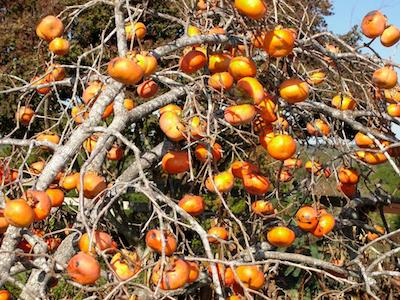
Asian persimmons are both edible and ornamental.
December 7, 2023 - Asian persimmons (Diospyros kaki) are eye-popping small ornamental trees. They have wonderful yellow and orange fall colors and produce copious quantities of large orange fruit that hang on the tree until winter. Many nongardeners refer to them as “tomato trees.” Though not common here, they have been cultivated in Texas for over a hundred years and in the Orient for thousands of years. They can be eaten fresh or dried, or made into breads, cakes, and puddings. Luckily, they are very easy to grow and can be produced completely organically having almost no insect or disease problems. Though many astringent types will pucker your mouth before they are completely soft and ripe, the non-astringent types can be eaten when they are crisp and firm, like an apple.
Asian persimmons are generally planted during the winter or early spring. They are available as both bare-root and containerized plants. When planting bare-root persimmons, it is absolutely a must that you plant them when they are dormant (leafless) during the winter. Containerized plants can be planted year-round, if moisture is available, with fall being the best time, winter second, spring third, and summer the worst. Asian persimmons should be spaced 10 to 20 feet apart.
Asian persimmons require full sun of at least eight hours a day to produce well. They can be grown in most any soils but prefer those that are well drained. Asian persimmons can grow in acid or moderately alkaline soils.
Dig a hole twice as wide as the tree’s root ball and as deep as the roots or pot it was in. Water the root ball in the hole and then backfill the hole with the native soil. Be careful not to plant the tree too deep or it will die. Create a circular berm around the tree that acts as a catch basin for water, and water the tree once a week (during June, July, and August) until it’s established. Put 1 to 2 inches of mulch (compost, pine straw, etc.) in a 3- to 4-foot circle around the plant to prevent weeds, moderate soil temperatures, and conserve moisture.
Asian persimmons require relatively little care, pruning, spraying, or fertilizing. They can be grown organically in Texas. Provide 1 to 2 inches of water per week when they are in fruit to prevent fruit drop.
Although they will ripen off the tree, persimmons should be left on the tree until they are full-sized, soft, and fully colored, generally around the first frost. If they are not ripe, they will be very astringent and pucker your mouth. Fuyu can be harvested when it is firm and crisp, as it is a non-astringent variety. Persimmons generally stay edible and hang on the tree until midwinter.
Persimmons are self-fruitful; however, fruit set and retention are often better when cross-pollinated by another cultivar. Seedless fruit can only occur without cross-pollination or by only having a single cultivar. Recommended cultivars for Texas include ‘Eureka’, ‘Fuyu’ (seedless, non-astringent), ‘Hachiya’ (seedless), ‘Tamopan’, and ‘Tane-nashi’ (seedless).
Greg Grant is the Smith County horticulturist for the Texas A&M AgriLife Extension Service. He is the author of Texas Fruit and Vegetable Gardening, Texas Home Landscaping, Heirloom Gardening in the South, and The Rose Rustlers. You can read his “Greg’s Ramblings” blog at arborgate.com and read his “In Greg’s Garden” in each issue of Texas Gardener magazine (texasgardener.com). More science-based lawn and gardening information from the Texas A&M AgriLife Extension Service can be found at aggieturf.tamu.edu and aggie-horticulture.tamu.edu.








